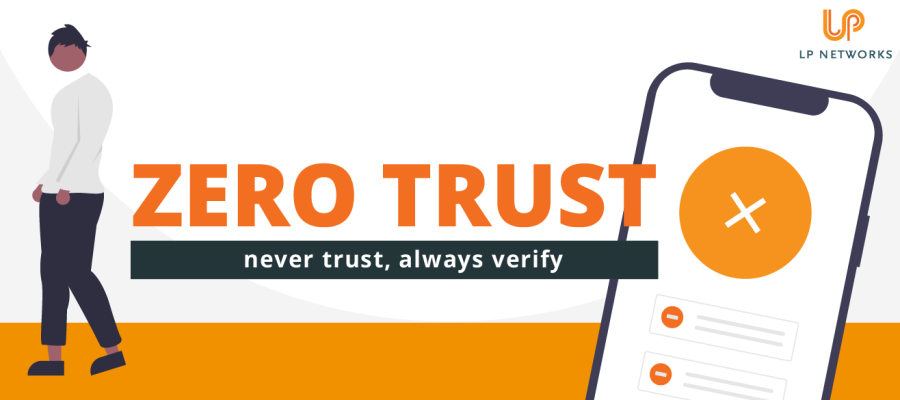- Solutions For
Specialist IT Support Services for:
- Popular Services
- Security
Security
- Our Expertise
Our Full Range of IT Services
- Learn
- About Us
- Contact
Posted 1st March 2023

In today's digital age, businesses rely on technology to conduct their operations. However, with this reliance comes the risk of cyber threats, which can have devastating consequences for the company and its customers. One way to mitigate these risks is by implementing a Zero Trust security model.
Zero Trust is a security philosophy that assumes all devices and users, even those inside a network, are untrusted until proven otherwise. The philosophy is based on the principle of "never trust, always verify." Every user, device and transaction are subject to strict security checks before being granted access to a network or its resources (such as files and documents), every step of the way.
The concept of Zero Trust is becoming increasingly important in the world of cyber security.The traditional approach to network security, known as the "castle and moat" model, assumes that everyone is trusted once a device or user is inside the network. However, this approach is no longer totally effective in today's digital world, where cyber threats can come from anywhere and take many forms. Zero Trust, however, assumes that all devices and users, even those inside a network, are a potential security risks which must be verified before being granted access as users move around the IT infrastructure and folder systems.
Your businesses should consider adopting a Zero Trust cybersecurity strategy because it helps improve your organisation's overall security position, reduces the risk of data breaches, and protect sensitive data from unauthorised access.
Here are some key reasons why a Zero Trust cyber security strategy is important:
Many businesses and industries are subject to strict regulations regarding the protection of sensitive data. A Zero Trust approach can help businesses comply with these regulations by providing granular level control over system and data access and usage. By segmenting and controlling access to sensitive data, Zero Trust can help minimise the data exposure risk and maintain compliance with regulations such as GDPR.
A Zero Trust strategy requires businesses to have a detailed understanding of their network and data, which can help to identify potential security risks and vulnerabilities. This enhanced visibility and control can help businesses proactively prevent security incidents before they occur. By continuously monitoring user and device behaviour, Zero Trust can provide valuable insights into network and data usage, enabling businesses to proactively identify and address potential security issues before they become a problem. This enhanced visibility and control can help businesses to stay ahead of potential security threats and improve their overall security position.
With the rise of remote work, businesses need to secure their networks and data regardless of the location where their employees are working from. A Zero Trust approach provides a framework for securing remote access and can help businesses maintain security even when employees work from home or other remote locations. By continuously verifying identity and access, Zero Trust can help to prevent unauthorised access and reduce the risk of data breaches, even when employees are working outside the traditional office environment.
With the increasing complexity and sophistication of cyber-attacks, traditional security measures such as firewalls and antivirus software are no longer sufficient. A Zero Trust approach can help to protect against advanced threats such as malware, phishing attacks, and ransomware. As a Zero Trust cyber security strategy is designed to continuously monitor user and device behaviour to detect potential threats. If, a hacker manages to bypass the initial security controls, such as a password, they will still need to provide proper authentication and authorisation to access additional resources.
As Zero Trust strategies involves verifying every user and device that tries to access the business network and data, it means that even if a hacker manages to breach one point of entry, they will still be denied access to the rest of the network. This reduces the risk of a data breach and limits the damage that can be done in the event of a breach. By segmenting and controlling access to resources, Zero Trust can significantly reduce the risk of a data breach and limit the damage that can be done in the event of a breach.
LP Networks will help you understand the practical steps involved in implementing a Zero Trust approach. Our cyber security consultant will work with you to develop a detailed implementation plan, which will include technology and process requirements, and the role of internal and external resources. We can then provide ongoing support to ensure that the implementation is successful and effective in enhancing your overall cyber security position.
Implementing a Zero Trust security model requires a multi-layered approach that includes the:
A Zero Trust security approach is not a one-time implementation but an ongoing process that requires continuous monitoring, updates, and maintenance. By adopting a Zero Trust security model, businesses can better protect themselves against cyber threats and ensure the integrity and confidentiality of their data.
The benefits of Zero Trust are clear, but there are also some risks associated with it:
Zero Trust is an important step in protecting your data and systems despite these risks. If you are a business, it is essential to understand the cyber security threats to your business, as well as the benefits and risks of a Zero Trust approach; and to make the necessary adjustments to your security strategy.
Our firm will work with you to conduct a comprehensive risk assessment to identify the specific security risks that your business faces, including external threats such as phishing attacks and malware, and internal threats such as unauthorised access or data exfiltration.
Once we have identify the specific security risks that your business is most vulnerable to, we can assess whether a Zero Trust approach would be effective in mitigating those risks.
Implementing a Zero Trust approach to cyber security may require an investment in new technology and processes, which can represent an expense for a business. However, the cost of a Zero Trust approach will depend on a variety of factors, including the size and complexity of the network, the level of security required, and the existing security infrastructure in place.
Some of the potential costs associated with implementing a Zero Trust approach are:
So, whilst there may be some costs associated with implementing a Zero Trust approach, the benefits of improved security and reduced risk of data breaches can outweigh the costs.
Additionally, there are often cost-effective ways to implement a Zero Trust approach, such as leveraging existing security infrastructure and implementing security controls in a phased approach.
The financial cost to a business of not implementing a Zero Trust approach can vary depending on the severity and impact of a cyber security incident they then go on to suffer. However, data breaches and other security incidents can have significant financial consequences for businesses.

